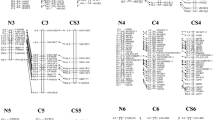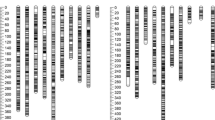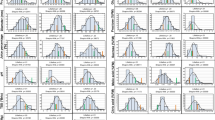Summary
Genetic linkage analysis was performed using two segregating populations of citrus. One population arose from an intergeneric backcross of Citrus grandis (L.) Osb. cv ‘Thong Dee’ and Poncirus trifoliata (L.) Raf. cv ‘Pomeroy’, using the former as the recurrent (female) parent. The other population came from an interspecific backcross of C. reticulata Blanco cv ‘Clementine’ and C. x paradisi Macf. cv ‘Duncan’, using the former as the recurrent (male) parent. A total of 11 isozyme and 58 restriction fragment length polymorphisms were found to segregate in a monogenic fashion in one or both populations. Linkage analysis revealed that 62 of the loci examined mapped to 11 linkage groups, while 7 loci segregated independently from all other markers. Gene order was highly conserved between the maps generated from the two divergent segregating populations. Possible applications of the use of such maps in tree fruit breeding are discussed.
Similar content being viewed by others
References
Barrett HC (1977) Intergenic hybridization of Citrus and other genera in citrus cultivar improvement. Proc Int Soc Citricult 2:586–589
Barrett HC (1985) Hybridization of Citrus and related genera. Fruit Var J 39:11–16
Bernatzky R, Tanksley SD (1986b) Towards a saturated linkage map in tomato based on isozymes and random cDNA sequences. Genetics 112:887–898
Bonierbale MW, Plaisted RL, Tanksley SD (1988) RFLP maps based on a common set of clones reveal modes of chromosomal evolution in potato and tomato. Genetics 120:1095–1103
Bournival BL, Scott JW, Vallejos CE (1989) An isozyme marker for resistance to race 3 of Fusarium oxysporum f. sp. lycopersici in tomato. Theor Appl Genet 78:489–494
Burr BF, Burr A, Thompson KH, Albertson MC, Stuber CW (1988) Gene mapping with recombinant inbreds in maize. Genetics 118:519–526
Church GM, Gilbert W (1984) Genomic sequencing. Proc Natl Acad Sci USA 81:1991–1995
Dellaporta SL, Wood J, Hicks JB (1983) A plant DNA minipreparation: version II. Plant Mol Biol Rep 1:19–21
Durham RE (1990) Mapping genes involved in freezing tolerance in a backcross of Citrus and Poncirus using a linkage map of isozymes and restriction fragment length polymorphisms. PhD thesis, University of Florida, Gainesville
Durham RE, Moore GA, Sherman WB (1987) Isozyme banding patterns and their usefulness as genetic markers in peach. J Am Soc Hortic Sci 112:1013–1018
Gebhardt C, Ritter E, Debener T, Schachtschabel V, Walkemeier B, Uhrig H, Salamini F (1989) RFLP analysis and linkage mapping in Solomon tuberosum. Theor Appl Genet 78:65–75
Guerra MS (1984) Cytogenetics of Rutaceae. II. Nuclear DNA content. Caryologia 37:219–226
Hanahan D (1985) Techniques for transformation of E. coli. In: Glover DM (ed) DNA cloning, vol. 1: a practical approach. IRL Press, Oxford, England, pp. 109–135
Handa T, Ishizawa Y, Oogoki C (1986) Phylogenetic study of fraction 1 protein in the genus Citrus and its close related genera. Jpn J Genet 61:15–24
Harlow E, Lane D (1988) Antibodies: a laboratory manual. Cold Spring Harbor Laboratory Press, Cold Spring Harbor, N.Y.
Havey MJ, Muehlbauer FJ (1989) Linkages between restriction fragment length, isozyme, and morphological markers in lentil. Theor Appl Genet 77:395–401
Helentjaris T, Slocum M, Wright S, Schaefer A, Nienhuis J (1986) Construction of genetic linkage maps in maize and tomato using restriction fragment length polymorphisms. Theor Appl Genet 72:761–769
Janick J, Moore JN (eds) (1975) Advances in fruit breeding. Purdue University Press, West Lafayette, Ind.
Kosambi DD (1944) The estimation of map distances from recombination values. Ann Eugenet 12:172–175
Laemmli UL (1970) Cleavage of structural proteins during the assembly of the head of bacteriophage T4. Nature 227:680–685
Lander ES, Green P, Abrahamson J, Barlow A, Daly MJ, Lincoln SE, Newburg L (1987) Mapmaker: an interactive computer package for constructing primary genetic linkage maps of experimental and natural populations. Genomics 1:174–181
Landry BS, Kesseli RV, Farrara B, Michelmore RW (1987) A genetic map of lettuce (Lactuca sativa L.) with restriction fragment length polymorphism, isozyme, disease resistance and morphological markers. Genetics 16:331–337
Liou P-C (1990) A molecular study of the citrus genome through restriction fragment length polymorphism and isozyme mapping. PhD thesis, University of Florida, Gainesville
Maniatis T, Fritsch EF, Sambrook J (1982) Molecular cloning, a laboratory manual. Cold Spring Harbor Laboratory Press, Cold Spring Harbor, N.Y.
Martin B, Nienhuis J, King G, Schaefer A (1989) Restriction fragment length polymorphisms associated with water use efficiency in tomato. Science 243:1725–1728
Moore GA, Castle WS (1988) Morphological and isozymic analysis of open-pollinated citrus rootstock populations. J Hered 79:59–63
Moore JN, Janick J (eds) (1983) Methods in fruit breeding. Purdue University Press, West Lafayette, Ind.
Nienhuis J, Helentjaris T, Slocum M, Ruggero B, Schaefer A (1987) Restriction fragment length polymorphism analysis of loci associated with insect resistance in tomato. Crop Sci 27:797–803
Paterson AH, Lander ES, Hewitt JD, Peterson S, Lincoln SE, Tanksley SD (1988) Resolution of quantitative traits into Mendelian factors by using a complete linkage map of restriction fragment length polymorphisms. Nature 335:721–726
Paterson AH, DeVerna JW, Lanini B, Tanksley SD (1990) Fine mapping of quantitative trait loci using selected overlapping recombinant chromosomes, in an interspecies cross of tomato. Genetics 124:734–742
Roose ML (1988) Isozymes and DNA restriction fragment length polymorphisms in citrus breeding and systematics. In: Goren R, Mendel K (eds) Proc 6th Citrus Cong. Margraf Scientific Books, Weikersheim, FRG, pp 57–67
Roose ML, Gottlieb ML, Traugh SD (1988) A single gene specifies the small subunit of ribulose-1,5-biphosphate carboxylase in citrus. Genome 30 [Suppl 1]:452
Sarfatti M, Katan J, Fluke R, Zamir D (1989) An RFLP marker in tomato linked to Fusarium oxysporum resistance gene I2. Theor Appl Genet 78:755–759
Soost RK, Cameron JW (1975) Citrus. In: Janick J, Moore JN (eds) Advances in fruit breeding. Purdue University Press, West Lafayette, Ind., pp 507–540
Suiter KA, Wendel JF, Case JS (1983) Linkage-1: A PASCAL computer program for the detection and analysis of genetic linkage. J Hered 74:203–304
Suzuki DT, Griffiths AJF, Lewontin RC (1981) An introduction to genetic analysis, 2nd edn. Freeman Press, San Francisco
Tanksley SD, Midina-Filho H, Rick CM (1981) The effect of isozyme selection on metric characters in an interspecific backcross of tomato-basis of an early screening procedure. Theor Appl Genet 60:291–296
Tanksley SC, Bernatzky R, Lapitan NL, Prince JP (1988) Conservation of gene repertoire but not gene order in pepper and tomato. Proc Natl Acad Sci USA 85:6419–6423
Torres AM (1983) Fruit trees. In: Tanksley SD, Orton TJ (eds) Isozymes in plant genetics and breeding, part 1B. Elsevier, Amsterdam, pp 401–421
Torres AM (1989) Isozyme analysis of tree fruits. In: Soltis DE, Soltis PS (eds) Isozymes in plant biology. Dioscorides Press, Portland, Ore., pp 192–205
Torres AM, Soost RK, Diedenhofen U (1978) Leaf isozymes as genetic markers in citrus. Am J Bot 65:869–881
Torres AM, Soost RK, Mau-Lostovicka T (1982) Citrus isozymes: genetics and distinguishing nucellar from zygotic seedlings. J Hered 73:335–339
Torres AM, Mau-Lostovicka T, Williams TE, Soost RK (1985) Segregation distortion and linkage of Citrus and Poncirus isozyme genes. J Hered 76:289–294
Weeden NF (1989) Application of isozymes in plant breeding. In: Janick J (ed) Plant breeding reviews, vol 6. Timber Press, Portland, Ore., pp 11–54
Young ND, Zamir D, Ganal MW, Tanksley SD (1988) Use of isogenic lines and simultaneous probing to identify DNA markers tightly linked to the TM-2a gene in tomato. Genetics 120:579–589
Zamir D, Tadmor Y (1986) Unequal segregation of nuclear genes in plants. Bot Gaz 147:355–358
Author information
Authors and Affiliations
Additional information
Communicated by F. Salamini
Rights and permissions
About this article
Cite this article
Durham, R.E., Liou, P.C., Gmitter, F.G. et al. Linkage of restriction fragment length polymorphisms and isozymes in Citrus . Theoret. Appl. Genetics 84, 39–48 (1992). https://doi.org/10.1007/BF00223979
Received:
Accepted:
Issue Date:
DOI: https://doi.org/10.1007/BF00223979




